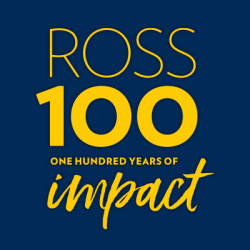Business Case Discussion: What We’re Looking For

At Michigan Ross, we have a rubric for each aspect of our application materials that guide our reading team when assessing applications for admission. For transparency, I am sharing several elements within our rubric as they relate to the Business Case Discussion portion of the Ross Admissions Portfolio.
But first, let me remind you of what the discussion prompt is and why we have chosen this particular exercise for our portfolio.
Business Case Discussion Prompt: Choose a current event or issue in your community and discuss the business implications. Propose a solution that incorporates business principles or practices. The review panel will look for creativity, drawing connections, and originality. (maximum 500 words)
The Business Case Discussion allows us to learn more about your understanding of business and how you solve problems. It is an exercise in both critical thinking and business exploration. And it gives our admissions team a view into your thought process, and your interest in business education.
Overall, the Ross Admissions Portfolio is a personal, open-ended way for you to share more about who you are and your interest in business. Our admissions team utilizes the portfolio as a complement to your Common Application to get a well-rounded understanding of who you are. We know that you are more than a number, and we value that.
What we’re looking for. Straight from the rubric…
Writing Style - We are looking for a well-written piece that clearly communicates your ideas. Essentially, we are assessing your ability to write with clarity.
Content — Showcase content that is personal! The trick with any college admissions writing assignment is to add in elements of who you are as a person. That content should be relevant (nothing from middle school), concrete (show us through examples), and mature (stay away from humor).
Topic Choice — The problem you choose to solve should be unique to YOUR interests, experiences, and knowledge. I emphasize “your” because there is no “right” or “wrong” problem to solve — it's truly up to you. Ask yourself, did you pick a topic you are passionate about? And remember not to choose a global topic you are disconnected from.
Definition of the Problem/Explanation of the Issue - Right out of the gate, clearly state the problem or issue you intend to solve. No need to provide background information, or a lengthy introduction. Remember, it's only 500 words.
Business Implications — This is where the problem statement is further defined. What are the issues this problem is causing? Then, more specifically, what are the business issues? Use two or three sentences to make connections to areas of business.
Problem Solving — Details! Provide a concrete example or two that describes your solution in detail. (And remember that a mobile app does not solve every issue in this world.) Not only are we looking for a logical plan, but we are looking for you to recognize and articulate the reason(s) for your solution.
Existing Knowledge — Reviewers are looking for what existing knowledge of business you may already have. Ask yourself, are there business principles or practices you have learned through coursework, a business club or activity, or through your own exploration? Ideally, you are presenting business implications and solutions that you clearly understand.
Personal Connections and Reflections — All of the writing exercises you complete for your college admission applications should be reflective in nature. We are looking for an awareness of your own personal views and/or experience regarding your chosen topic. Can you articulate a personal connection to the chosen topic? Because at the end of the day, we are reading applications to understand more about you as a person and your unique interest in business.





